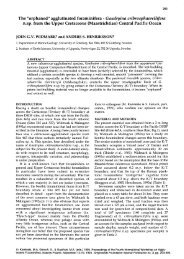Full Text | Download - Grzybowski Foundation - The ...
Full Text | Download - Grzybowski Foundation - The ...
Full Text | Download - Grzybowski Foundation - The ...
Create successful ePaper yourself
Turn your PDF publications into a flip-book with our unique Google optimized e-Paper software.
Alegret, Ortiz & Kaminski (eds.), 2012. Ninth International Workshop on Agglutinated Foraminifera, Abstract Volume<br />
<strong>The</strong> life cycle of Entzia (Foraminifera) in the salt marsh at Turda, Romania<br />
Andreea TELESPAN 1 , Michael A. KAMINSKI 2 , Ramona BALC 1 , Sorin FILIPESCU 3<br />
and Ildiko VARGA 1<br />
1 Babeş-Bolyai University, Faculty of Environmental Sciences, 30 Fântânele Street, 400294 Cluj-<br />
Napoca, Romania.<br />
2 Earth Sciences Department, King Fahd University of Petroleum & Minerals, Dhahram, 31261, Saudi<br />
Arabia.<br />
3 Babeş-Bolyai University, Department of Geology, 1 Mihail Kogălniceanu Street, 400084 Cluj-<br />
Napoca, Romania.<br />
e-mail: telespan.andreea@yahoo.com<br />
<strong>The</strong> study is focused on the modern agglutinated foraminifera living in a small salt marsh, in<br />
Turda, Romania. This marsh owes its presence to the Miocene deposits from Transylvania<br />
Basin, and is located less than a kilometer from the famous Maria <strong>The</strong>resa Salt Mine. <strong>The</strong><br />
studied area is the only place so far in Romania, a living Entzia population has been found.<br />
<strong>The</strong> future evolution of this Entzia population is endangered by human activity.<br />
Earlier records of the Entzia tetrastomella were mentioned by Daday (1884) from a<br />
locality in the city of Deva that no longer exists. <strong>The</strong> salt marsh in Deva is now beneath a<br />
health clinic car park.<br />
<strong>The</strong> samples for this study were collected monthly in order to follow the life cycle of the<br />
Entzia population. This species can be found today among the roots of the halophyte plants, in<br />
the uppermost centimeters of the mud. Two samples were collected at fixed time intervals for<br />
the purpose of monitoring the Entzia population and measuring different parameters, such as<br />
humidity, conductibility, salinity, pH, and temperature. <strong>The</strong> samples were stored for 24 hours<br />
in 40% alcohol (Vodka) with Rose Bengal, in order to distinguish between dead and live<br />
specimens. To document the entire life cycle of the species the following analyses have been<br />
carried out: test size, dynamics of population, number of chambers, and ratio between live and<br />
dead specimens.<br />
Based on the obtained measurements (test size and number of chambers) the largest<br />
specimens have been found in December–January and July-August when the asexual<br />
reproduction took place; the smallest specimens appeared in March-May when sexual<br />
reproduction can be presumed. This pattern is also sustained by the numbers of live and dead<br />
specimens (in January and August).<br />
94



